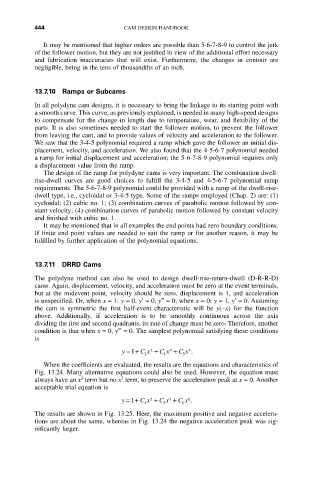Page 456 - Cam Design Handbook
P. 456
THB13 9/19/03 7:56 PM Page 444
444 CAM DESIGN HANDBOOK
It may be mentioned that higher orders are possible than 5-6-7-8-9 to control the jerk
of the follower motion, but they are not justified in view of the additional effort necessary
and fabrication inaccuracies that will exist. Furthermore, the changes in contour are
negligible, being in the tens of thousandths of an inch.
13.7.10 Ramps or Subcams
In all polydyne cam designs, it is necessary to bring the linkage to its starting point with
a smooth curve. This curve, as previously explained, is needed in many high-speed designs
to compensate for the change in length due to temperature, wear, and flexibility of the
parts. It is also sometimes needed to start the follower motion, to prevent the follower
from leaving the cam, and to provide values of velocity and acceleration to the follower.
We saw that the 3-4-5 polynomial required a ramp which gave the follower an initial dis-
placement, velocity, and acceleration. We also found that the 4-5-6-7 polynomial needed
a ramp for initial displacement and acceleration; the 5-6-7-8-9 polynomial requires only
a displacement value from the ramp.
The design of the ramp for polydyne cams is very important. The combination dwell-
rise-dwell curves are good choices to fulfill the 3-4-5 and 4-5-6-7 polynomial ramp
requirements. The 5-6-7-8-9 polynomial could be provided with a ramp of the dwell-rise-
dwell type, i.e., cycloidal or 3-4-5 type. Some of the ramps employed (Chap. 2) are: (1)
cycloidal; (2) cubic no. 1; (3) combination curves of parabolic motion followed by con-
stant velocity; (4) combination curves of parabolic motion followed by constant velocity
and finished with cubic no. 1.
It may be mentioned that in all examples the end points had zero boundary conditions.
If finite end point values are needed to suit the ramp or for another reason, it may be
fulfilled by further application of the polynomial equations.
13.7.11 DRRD Cams
The polydyne method can also be used to design dwell-rise-return-dwell (D-R-R-D)
cams. Again, displacement, velocity, and acceleration must be zero at the event terminals,
but at the midevent point, velocity should be zero, displacement is 1, and acceleration
is unspecified. Or, when x = 1: y = 0, y¢= 0, y≤= 0; when x = 0: y = 1, y¢= 0. Assuming
the cam is symmetric the first half-event characteristic will be y(-x) for the function
above. Additionally, if acceleration is to be smoothly continuous across the axis
dividing the first and second quadrants, its rate of change must be zero. Therefore, another
condition is that when x = 0, y = 0. The simplest polynomial satisfying these conditions
is
y =+ C x + C x + C x .
1
5
4
2
2 4 5
When the coefficients are evaluated, the results are the equations and characteristics of
Fig. 13.24. Many alternative equations could also be used. However, the equation must
3
2
always have an x term but no x term, to preserve the acceleration peak at x = 0. Another
acceptable trial equation is
y =+ C x + C x + C x .
2
5
6
1
2 5 6
The results are shown in Fig. 13.25. Here, the maximum positive and negative accelera-
tions are about the same, whereas in Fig. 13.24 the negative acceleration peak was sig-
nificantly larger.

